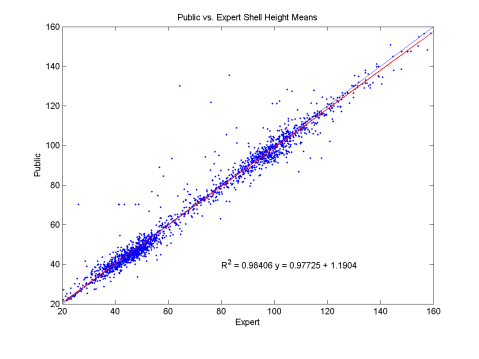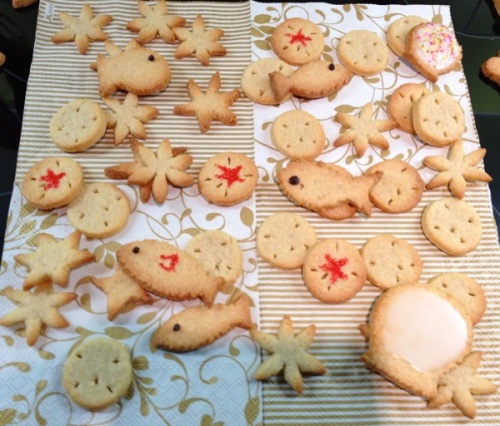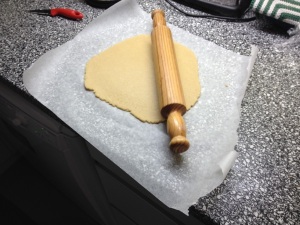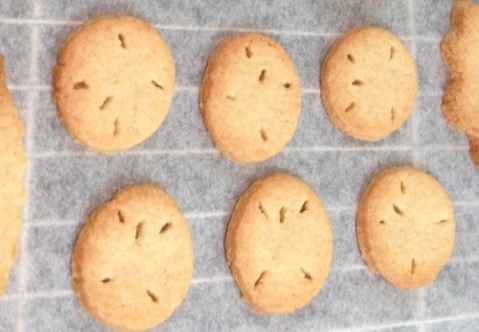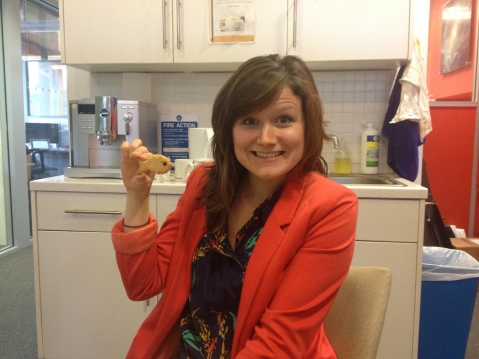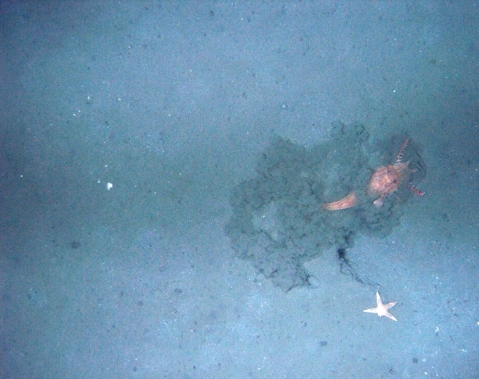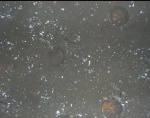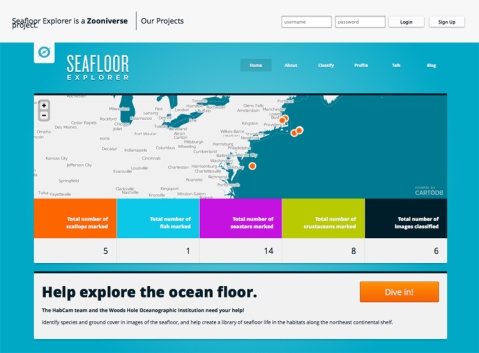1st Image set 100% Complete!
A huge thank you to everyone involved in helping the Seafloor Explorer complete this first round of images. We will crank away at the dataset and get you some preliminary results soon. Stay tuned because we will also be announcing the timing of the second round of image on the searfloorexplorer.org site.
And now an image of an armored searobin (family: Peristediidae) at a depth of 133m (436ft).
You’re doing great! Keep it up.
As of today we are 93% done with the first image set we put up on seafloor explorer. As we approach the end of this phase we would like to share some preliminary results. One analysis we did was public vs. expert scallop measurements. In other words, how close are scallop shell height measurements done by the public vs. someone who has been measuring scallops for years in scientific applications. We had an expert do a subset of the same images on seafloor explorer that we gave all of you and were extremely pleased to see that there was a really tight correlation. That measurements by the public are up to an expert level.
Crunchy, Buttery Sea Stars
The holidays are a great time to have a bit of fun in the kitchen. Here’s a recipe for butter cookies (adapted from Cook’s Country) that can be shaped into anything you like, including some of our underwater favorites:
| Ingredients | Preparation |
|---|---|
| 2 3/4 cups all-purpose white flour 1 1/4 cups granulated sugar 1 teaspoon baking powder 1/4 teaspoon table salt 2 large egg yolks 3/8 cup sour cream 1 tablespoon vanilla 1 1/2 sticks (12 tablespoons/175 g) unsalted butter |
1. Melt the butter and set aside to cool slightly.
2. In a large bowl, combine dry ingredients and whisk together. 3. In a smaller bowl, whisk egg yolks, sour cream, and vanilla until combined. Slowly add melted butter, whisking constantly, until mixture is smooth and homogeneous. 4. Pour wet ingredient mixture into dry ingredients; mix until flour is completely incorporated and the dough roughly makes a ball. 5. Turn dough out onto sheet of parchment paper (lightly floured if necessary), and separate into two halves. |
Some tips on rolling out the dough: it should be a bit chilled so that it won’t melt all over your fingers and stick to the rolling pin, but not so cold that it breaks when you shape it. An hour in the fridge or 20 minutes in the freezer should be about right, after which you should take it out, knead and shape it into a ball, preheat the oven, and then get rolling. As you work, if the dough gets too warm, just keep re-cooling it in the fridge.
On a sheet of parchment/baking paper, roll the dough out to about 1/8-inch (3.5 mm) thick. You can use a bit of flour to help keep things from sticking, but the more you use, the tougher the cookies will be. I didn’t use any at all, and it was fine.
Once you’ve cut out the shapes you’re making, you can re-knead the scraps together and re-roll the dough (possibly chilling it again) until you’ve used it all up.
Sand dollars: use a circle cutter, then make little notches as shown and optionally scratch the star into the surface to help with decorating later.
Sea stars: I started out cutting these by hand, which gives them a suitably organic look. But you can also use a star cutter and lengthen the arms by notching the cut stars in the middle and then shaping the rest by hand.
Fish and scallops: if you have appropriate-shaped cutters, go wild. I didn’t have them, so I had to freehand these. But I found that if you accidentally make the fish too fat and the tail too short, you end up with a scallop!
Bake the cookies in an oven heated to 325F (160C) until the edges of the cookies are golden brown. Cooking time will depend on your dough’s thickness and the size of the cookies as well as whether you’re using a convection/fan oven. If you’re using a conventional oven and a cold baking sheet, expect it to take 15 minutes and rotate the baking sheet at about 7 minutes in. For a fan oven it will take less time, especially if you use the parchment-paper-on-oven-rack method, as shown.
Decorating: make some simple icing by combining a lot of icing sugar (powdered sugar) with a little liquid until you have the right consistency (try a couple tablespoons of liquid and about a cup of sugar to start). For plain white icing, use milk. For a bit of citrus, try fresh lemon juice. You can also add food coloring or flavor extracts.
The icing can be a decoration on its own, or it can be a glue that holds other decorations on. Those decorations can include sprinkles of various sizes and shapes, colored sugars, and chocolate chips.
To make the fish eyes, I placed a mini chocolate chip at the right place on the cookie as soon as it came out of the oven. The chocolate melts from the residual heat, and when it firms up again it’s stuck there. If you want to make, say, scallops covered entirely with chocolate, put several chocolate chips on top, wait until they melt, and then use a spreading tool (in descending order of gadgetry: offset spatula, back of spoon, clean fingertip) to spread the melted chocolate around on top of the cookie. Harden the chocolate with a few minutes in the fridge.
What would be your preferred seafloor shape to bring to your next holiday party?
1 Million Classifications
Seafloor Explorer has been a big hit with the growing Zooniverse community. Three months since it launched, we’re celebrating an amazing milestone: over 1,000,000 classifications! Adding up all the time spent on Seafloor Explorer since it began, you have spent a collective 10 months on the site! A full time researcher would take more than two years to complete that number of images – working without breaks or holidays!
For today’s Zooniverse Advent Calendar entry we’ve created a collection of the most-collected and commented on images on Talk. There are some great pictures in here, and you often see amazing creatures and features in the HabCam images.
Possible new species? “convict worm”
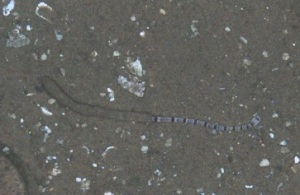 Be on the lookout! We are collecting images of a possible new species nicknamed the “convict worm” because of its black and white bands. It appears to be some kind of tube-dwelling worm. You can see images that have been found already by looking at the Convict Worm Collection or look at recent discussions that include the trend #convict-worm.
Be on the lookout! We are collecting images of a possible new species nicknamed the “convict worm” because of its black and white bands. It appears to be some kind of tube-dwelling worm. You can see images that have been found already by looking at the Convict Worm Collection or look at recent discussions that include the trend #convict-worm.
You can also “Dive In” to the Seafloor Explorer and start looking for some yourself.
Let us know if you can help narrow down this critter taxonomically!
WHOI announces the Seafloor Explorer project
The Woods Hole Oceanographic Institution put out a great press release about the project. Check it out.
Welcome to the seafloor!
The HabCam team is thrilled by the chance to interact with everyone on the Seafloor Explorer. We will be posting details about the HabCam project here on the blog such as at-sea research cruise pictures, interesting findings, and details about new development projects. Check back to be up-to date with all things HabCam.
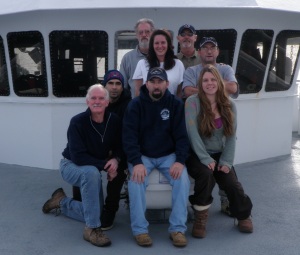
The HabCam Group aboard the F/V Kathy Marie. From left to right: Scott Gallager, Tony Melo, Richard Taylor, Paul Rosonina (front), Karen Bolles, Jarry Shervo, Donald Rosonina, Amber York (front).
Seafloor Explorer
It’s a busy month at the Zooniverse. Citizen Science September began with the relaunch of Galaxy Zoo two days ago and today we’re launching a whole new project: Seafloor Explorer. Just when you thought it was safe to go back into the water. The images come from HabCam, an underwater robot that takes wonderful images of the seafloor and its corals, fish, lobsters and much else
HabCam scientists need volunteers to help understand what they see in their data. At http://seafloorexplorer.org anyone can explore the HabCam images – many of which have never been seen before – and identify the creatures and terrain they see. The data you collect will be invaluable in determining the distribution of scallops, starfish and many other kinds of underwater species.
The HabCam imagery used in this project was collected in coastal regions of the Northeastern United States. To collect images, HabCam is towed from a ship and ‘flies’ approximately 2.5 m (6-8 ft.) above the seafloor, collecting six to 10 images per second. Getting help going through the millions of images collected is where you come in. We need your help to understand where these creatures are found and how they live.
We’re really excited to launch this project and hope you’ll enjoy diving under the surface to see what you can catch. Visit the new site now at http://seafloorexplorer.org. You can share your favourite images on Facebook and Twitter and we’ve also built in Talk, so you can discuss any curious creatures you spot.
You can read more on our official press release.


